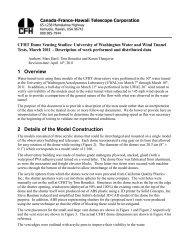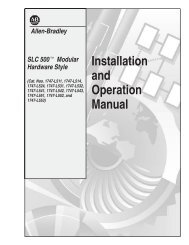Documentation [PDF] - Canada France Hawaii Telescope ...
Documentation [PDF] - Canada France Hawaii Telescope ...
Documentation [PDF] - Canada France Hawaii Telescope ...
You also want an ePaper? Increase the reach of your titles
YUMPU automatically turns print PDFs into web optimized ePapers that Google loves.
50% completeness are given for point-like (star or bulge) and for extended (disks) sources.<br />
The 80% and 50% completeness values are calculated from an automated fitting process applied to the<br />
catalogues of real and simulated sources without tuning. The limiting magnitudes are derived automatically<br />
by an empirical two parameter (x 0 ; α) fitting function<br />
(<br />
y = 100.0 × 1 − erf [x − x 0] α )<br />
+ 1.0<br />
2.0<br />
where x 0 provides the turn-over position of the completeness function and α is the function slope at x 0 .<br />
The parameters (x 0 ; α) are found from a standard χ 2 minimization. The 50% and 80% completeness<br />
limits are derived from a linear interpolation. An example of fit is given in Fig. 28. In some cases, the fit<br />
and the interpolation are not good and the completeness value is then poorly estimated.<br />
The completeness distributions over all the Wide fields and inside a Wide field are presented in Table 6.<br />
The left panel of Figure 29 shows the completeness distribution for the entire Wide survey for all four<br />
fields. Figure 30 shows the completeness distributions for each of the four Wide patches.<br />
The histograms coupled to a detailed inspection of the data show that the mean scatter in completeness<br />
is ±0.20 magnitudes, with significant variations from filter to filter. The completeness distribution in<br />
z-band is broader than other filters, with a tail that extends over one magnitude. In contrast, the r band<br />
distribution is narrower (± 0.15 mag.). This is due primarily to the large variations of the sky brightness<br />
through the years in that photometric band (OH emission lines), causing the variable depth on observations<br />
following a fixed exposure time model. Erratic behavior of the OH emission lines also leads to<br />
poorer correction of the fringes, aggravating the situation in the z-band.<br />
Figure 32 shows a series of completeness maps over the entire Wide fields. The maps are produced for<br />
each Wide field and for each filter.<br />
The left and right panels of Figure 31 shows that the completeness distribution are dominated by seeing,<br />
both for point sources and extended objects : better image quality corresponds to deeper images.<br />
Compared to the seeing contribution, the exposure time (even with double exposure time) has a smaller<br />
influence on the final depth measurement. For the u ∗ band, the range of limiting depth is likely broadened<br />
by the diversity of observing conditions (Moon, extinction, seeing). Nevertheless, (other than exposure<br />
time) the main factor affecting image completeness is the Seeing FWHM.<br />
The comparison with T0006 completeness is not straightforward. In T0006, the simulations were produced<br />
using a PSF of fixed FWHM equal to 0.9 arcsec. In T0007, the simulated PSF size matches the real<br />
PSF size of each tile. Since the actual seeing distribution peaks at an image quality better than 0.9 arcsec,<br />
the T0007 measured completeness of point sources is deeper than T0006. This increase in depth (around<br />
0.02 to 0.03mag in riyz) is therefore largely due to the measurement technique rather than changes in the<br />
images.<br />
Finally, Figure 33 shows the galaxy counts for the four Wide patches for each of the six bands, appropriately<br />
normalized in each case to the effective area after masking. The field-to-field agreement between<br />
the different patches is excellent, as is the match to the literature values.<br />
(12)<br />
4.4 Photometric accuracy<br />
In this Section we attempt to make a robust estimate of the internal photometric errors of the CFHTLS<br />
using a variety of methods. Although Scamp provides an estimate of the internal photometric error<br />
(between individual MegaCam images), we instead focus on the photometric errors in the final tiles.<br />
42


![Documentation [PDF] - Canada France Hawaii Telescope ...](https://img.yumpu.com/26965302/54/500x640/documentation-pdf-canada-france-hawaii-telescope-.jpg)









